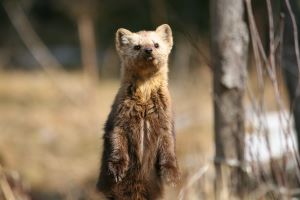Please activate JavaScript in your browser to use all interface options.
Scientists Confirm Increase in Siberian Sable Population Thanks to Vostsibneftegaz Grant
20 January 2023
Scientists of the Central Siberian State Nature Reserve have summarised their findings on the Siberian sable in the Evenki district of Krasnoyarsk Territory. The research, organised with grant support from the East Siberian Oil and Gas Company (Vostsibneftegaz), helped to update the state of the sable population in the forest areas after many years of wildfires.
It has been established that over the last 5 years the number of sable in Evenkia has been growing and has reached about 160,000 individuals, with an average density of 4 individuals per 1,000 hectares. Ecologists believe that this is due to the animal’s growing food base – the abundance of rodents and vegetation, as well as the low level of anthropogenic impact.
Scientists have also found that wildfires have a dual impact on the sable population. Habitats of this animal are expanding in areas recovering from wildfires. It is explained by the fact that different types of cereals, the main food of rodents, begin to grow abundantly on the burnt-out areas. After extensive wildfires, habitat structure is disturbed and the food base is changed, resulting in a decrease in sable population density. The large open spaces that occur in these cases are atypical habitats that the animal avoids. Active settling of animals on overgrown burnt areas is confirmed by photo traps set up by the reserve’s specialists.
Biometric data were taken from the sables and the sex composition was determined. Studies have shown that the sable is a euryphagous animal that feeds on animal and plant foods (small rodents, pine nuts, upland birds). Rodents account for more than 70% of the sable’s diet, with nuts and berries accounting for the rest. Adult sables are predominantly sedentary, with migrations occurring along river corridors in the absence of food.
Overall, the studies conducted confirm an increasing trend in sable population in Evenkia.
Note for Editors:
The East Siberian Oil and Gas Company, a subsidiary of Rosneft Oil Company, develops the Yurubcheno-Tokhomskoye oil and condensate field in the Evenki district of the Krasnoyarsk Territory.
Supporting the traditional way of life of the indigenous people of Evenkia is one of the key lines of the social work of the company. During the years of the work in the region, Vostsibneftegaz has implemented a lot of social, charitable and grant programmes, running since 2014. During this time, the company has supported more than 20 scientific projects, including projects to study the population of wild reindeer, a bioindicator species of the Arctic zone, Siberian sable and lesser white-fronted goose, to preserve the Evenki language, to study the ecosystems of the Tungusky reserve, to develop the first Red Book of Evenkia, biotechniques of artificial reproduction of Siberian taimen.
The implementation of the grant schemes helps save the unique natural environment, national culture, traditional way of life and cultural authenticity of the indigenous population of Evenkia.
Rosneft
Information Division
January 20, 2023

-315xx70.png)

